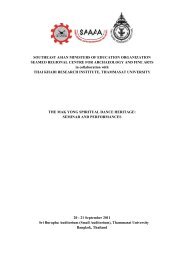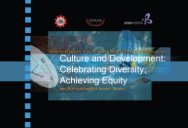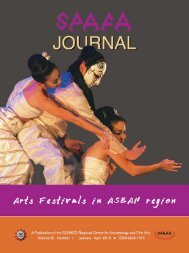on Culture & Development - Seameo-SPAFA
on Culture & Development - Seameo-SPAFA
on Culture & Development - Seameo-SPAFA
- No tags were found...
You also want an ePaper? Increase the reach of your titles
YUMPU automatically turns print PDFs into web optimized ePapers that Google loves.
100Activity 4.5, like 4.3, recommendsentering into dialogue with an openmind. Following stereotypes andnorms does not provide us withreliable clues, and acting <strong>on</strong> limitedinformati<strong>on</strong> can be misleading. Am<strong>on</strong>gthe facilitators there were somereservati<strong>on</strong>s about whether to use thisage line up since it may serve toreinforce an age hierarchy within thegroup. On each occasi<strong>on</strong>, based <strong>on</strong>observati<strong>on</strong>s of group dynamics <strong>on</strong>previous days, as well as feedbackduring the daily reviews, we did use itand discovered it was the source ofmuch laughter. Participants wereinvariably surprised by the final line upand this provided a great platform forc<strong>on</strong>structive discussi<strong>on</strong> related to ourattitudes towards age, experience,creativity and respect, linking back tothe values introduced in the culturalmapping activity of Day 1.Whether through a quick characterassessment based <strong>on</strong> the few days ofthe workshop as in Colleague CardSort or a hasty decisi<strong>on</strong> regarding whoshould receive sp<strong>on</strong>sorship to attend ac<strong>on</strong>ference, Activity 4.6 draws out thefeelings associated with judging andbeing judged. Tensi<strong>on</strong> rises asparticipants are pressured into judgingothers, and into making decisi<strong>on</strong>s theyfeel are neither fair nor informed. Byimposing unrealistic time frames andgiving <strong>on</strong>ly limited informati<strong>on</strong> to workwith, the comfort levels of the groupare challenged. This discomfort,however, provides the fuel for a livelyand animated follow up discussi<strong>on</strong> <strong>on</strong>how they felt throughout the process.Parallels are drawn to our workc<strong>on</strong>texts, with recogniti<strong>on</strong> given to thefact that many of us are all toofamiliar with making decisi<strong>on</strong>s in thisway, and in some cases <strong>on</strong> a regularbasis.In an ideal world, all the relevantstakeholders should have input toinfluence and resp<strong>on</strong>d to judgementsbeing made about them and <strong>on</strong> theirbehalf. They should also be included inthe decisi<strong>on</strong> making process. However,we must also be realistic. Asindividuals many of us are not in apositi<strong>on</strong> to change the work practicesof our organisati<strong>on</strong>s, at least notovernight. What we can do is to bemore aware of the c<strong>on</strong>sequences ofthe decisi<strong>on</strong>s we do make, the acti<strong>on</strong>swe initiate and the acti<strong>on</strong>s weendorse. We can also, as Chambers(2004) points out, “…be alert formoments and places where smallacti<strong>on</strong>s can have big effects.” It is upto each of us as individuals to take thefirst steps toward change, at leastwithin our immediate area of influenceand the relati<strong>on</strong>ships we build withcolleagues in our organisati<strong>on</strong>s orcounterparts from other stakeholdergroups.










